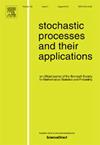First passage percolation with recovery
IF 1.1
2区 数学
Q3 STATISTICS & PROBABILITY
引用次数: 0
Abstract
First passage percolation with recovery is a process aimed at modeling the spread of epidemics. On a graph place a red particle at a reference vertex and colorless particles (seeds) at all other vertices. The red particle starts spreading a red first passage percolation of rate 1, while all seeds are dormant. As soon as a seed is reached by the process, it turns red and starts spreading red first passage percolation. All vertices are equipped with independent exponential clocks ringing at rate , when a clock rings the corresponding red vertex turns black. For , let and denote the size of the longest red path and of the largest red cluster present at time . If is the semi-line, then for all almost surely and . In contrast, if is an infinite Galton–Watson tree with offspring mean then, for all , almost surely and , while , for all . Also, almost surely as , for all is of order at most . Furthermore, if we restrict our attention to bounded-degree graphs, then for any there is a critical value so that for all , almost surely .
第一段渗滤与回收
带恢复的第一通道渗流是一种旨在模拟流行病传播的过程。在一个图 G 上,在参考顶点 o 处放置一个红色粒子,在所有其他顶点放置无色粒子(种子)。红色粒子开始传播速率为 1 的红色第一通道渗流,而所有种子处于休眠状态。一旦进程到达某个种子,它就会变成红色,并开始传播红色第一通道渗流。所有顶点都配有独立的指数时钟,以 γ>0 的速率振铃,当时钟振铃时,相应的红色顶点变黑。对于 t≥0,让 Ht 和 Mt 表示 t 时刻存在的最长红色路径和最大红色集群的大小。如果 G 是半直线,那么对于所有 γ>0 几乎肯定 lim suptHtloglogtlogt=1 和 lim inftHt=0。相反,如果 G 是一棵后代均值为 m>1 的无限加尔顿-沃森树,那么对于所有 γ>0,几乎可以肯定 lim inftHtlogtt≥m-1 和 lim inftMtlogtt≥m-1,而对于所有 c>m-1,lim suptMtect≤1。此外,如果我们把注意力限制在有界度图上,那么对于任何 ɛ>0 都有一个临界值 γc>0,这样对于所有 γ>γc,几乎可以肯定 lim suptMtt≤ɛ。
本文章由计算机程序翻译,如有差异,请以英文原文为准。
求助全文
约1分钟内获得全文
求助全文
来源期刊

Stochastic Processes and their Applications
数学-统计学与概率论
CiteScore
2.90
自引率
7.10%
发文量
180
审稿时长
23.6 weeks
期刊介绍:
Stochastic Processes and their Applications publishes papers on the theory and applications of stochastic processes. It is concerned with concepts and techniques, and is oriented towards a broad spectrum of mathematical, scientific and engineering interests.
Characterization, structural properties, inference and control of stochastic processes are covered. The journal is exacting and scholarly in its standards. Every effort is made to promote innovation, vitality, and communication between disciplines. All papers are refereed.
 求助内容:
求助内容: 应助结果提醒方式:
应助结果提醒方式:


